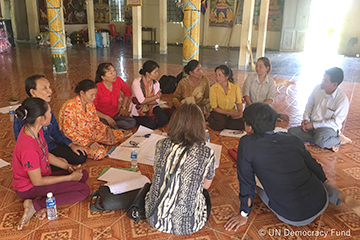Gender Equality: The View from the UN
Sawanishi Mikiko (Japan)
Deputy Executive Head, United Nations Democracy Fund (UNDEF) / ALFP 2018 Fellow
The overwhelming majority of Japanese nationals working at United Nations agencies in New York are female. The directory of UN staff alone lists approximately 200 Japanese names, of whom 70% are women. More Japanese women have recently been joining the ranks of senior-level professionals (D1 and above). This may be a reflection of one of the Secretary-General’s goals to achieve greater gender parity by increasing the representation of women in the UN system as a whole, especially in executive and other senior professional positions.1 UN staff is divided into professional and general service staff, with the latter offering administrative, secretarial and clerical support for the former. Not surprisingly, there are far more women in general service positions. In professional positions, a sizable number of women work as entry level professionals (P1 and P2). Also, recently the UN Secretary-General took a strong initiative and has achieved gender parity in his senior management team, composed of the UN Secretariat’s departmental heads and heads of UN agencies, funds and programmes. However, men are still dominant at middle and executive level positions, which are responsible for day-to-day decision making. There is clearly a glass ceiling.
Equal opportunity and higher status for women have long been key issues for the United Nations, which established the Commission on the Status of Women in 1946 and adopted the Convention on the Elimination of All Forms of Discrimination against Women (CEDAW) in 1979. Japan ratified the convention in 1985, leading to the repeal of many discriminatory practices. I was still a student at the time, but when I saw job opportunities opening up for positions that had previously been offered only to men, I realized that UN initiatives did have a real-life impact—even in a country as far away as Japan. That may have been my first encounter with the United Nations. Efforts made since then include the adoption of an optional protocol to the CEDAW in 1999 allowing complaints to be submitted directly to the CEDAW and the inclusion of gender equality as the fifth of the 17 Sustainable Development Goals to be achieved by 2030.
As Deputy Executive Head of the United Nations Democracy Fund (UNDEF), I work to promote democracy at the grassroots level. Promoting gender equality is an essential component of all our projects, whose concrete goals are often to encourage greater participation of women in political and other forms of decision-making.2 In implementing our projects, we work closely with local civil society organizations, many of whose leaders and members are women. Our mission is to promote inclusivity of not just women but all groups in the decision-making process.

Cambodian women discussing a climate resilience plan in their commune
In India, I have seen women acquire employable skills that lead to greater financial independence, a bigger voice in society and active engagement in addressing community issues. In Philippine and Cambodian communities, women have actively proposed and implemented disaster-prevention and mitigation measures as climate change has exacerbated floods and droughts. In Malaysia, I was moved by a group of Islamic women who boldly advocated an interpretation of Islamic family law in line with modern realities, in spite of repeated threats from conservative groups.
Efforts to achieve gender equality continue to be made in Asia and elsewhere, but the path is arduous. True democracy will remain elusive until individuals are free to attain their goals and contribute to society, regardless of gender or sexual orientation.
Activists in many countries point to enduring preconceptions about gender roles as major obstacles to gender equality. Gender stereotypes are difficult to overcome, resulting in the building and maintaining of social institutions based on those stereotypes, which in turn further reinforce them. Patriarchal gender roles persist to one extent or another in all societies, perhaps with the exception of the Nordic countries. And while it is not unusual to find women holding senior positions in Asian countries outside Japan, those with whom I work tell me how exasperated they are with lingering male-centric attitudes and customs.
In Japan, too, traditional notions of gender roles at work and at home remain strong, and they underlie many of the country’s workplace practices and social institutions. A case in point is the long working hours premised on a domestic division of labor; spouses who work late every day are unlikely to be actively engaged at home, and this has been cited as a factor behind the declining birthrate. The reason so many Japanese women work at the United Nations, I suspect, is not just because they are interested in contributing to the international community but because they are better able to balance work and family life here than in Japan. Changing such ingrained ideas will require both a top-down approach through the establishment of new international norms, like the CEDAW, and bottom-up efforts by individuals to effect a shift in consciousness both in the home and at work. I hope that by the time our daughters enter the workforce, society will have evolved to become more welcoming to all those eager to play an active role, regardless of gender. I also intend to do whatever I can on a personal level to make that wish come true and to also work assiduously alongside other women to seek needed reforms.
The contents of this article reflect solely the opinions of the author.



